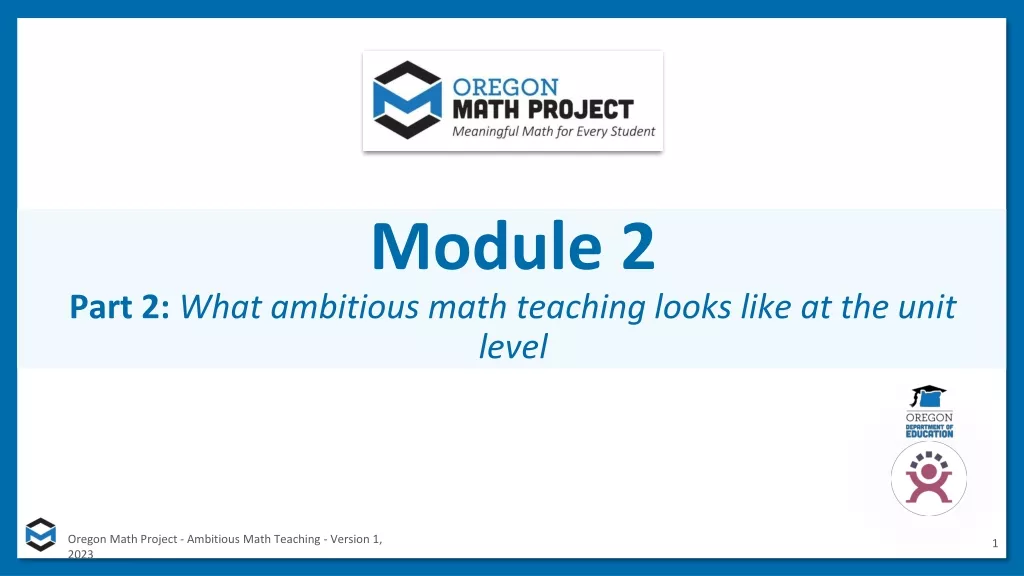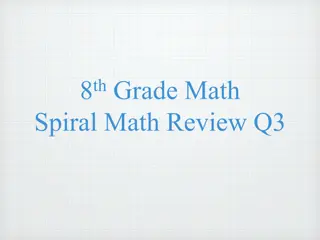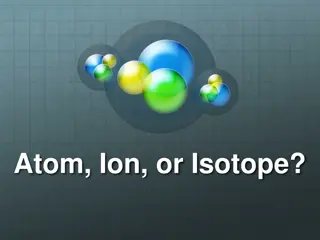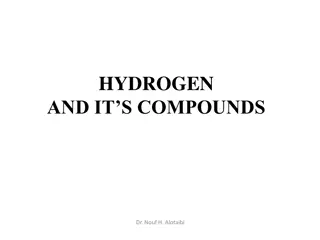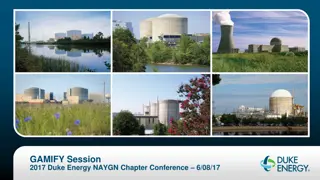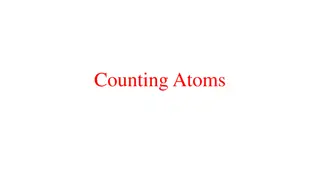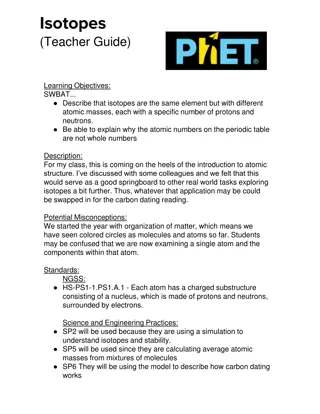
Weighted Atomic Mass Calculation for Element Ao Isotopes
Learn how to calculate the average weighted atomic mass of element Ao using the masses and proportions of its three naturally occurring isotopes. Understand the importance of isotopes and how their proportions affect the overall atomic mass of an element.
Download Presentation

Please find below an Image/Link to download the presentation.
The content on the website is provided AS IS for your information and personal use only. It may not be sold, licensed, or shared on other websites without obtaining consent from the author. If you encounter any issues during the download, it is possible that the publisher has removed the file from their server.
You are allowed to download the files provided on this website for personal or commercial use, subject to the condition that they are used lawfully. All files are the property of their respective owners.
The content on the website is provided AS IS for your information and personal use only. It may not be sold, licensed, or shared on other websites without obtaining consent from the author.
E N D
Presentation Transcript
Math Review for Matter and Atomic Theory Get reference tables, white paper, and calculators now. (hurry)
Isotopes are chemically identical atoms, with different numbers of neutrons. They exist, but for no apparent reason. They just are. All atoms are isotopes, some are the most common isotopes of that element. Any isotope can be in the ground state, or excited state. Each atom in high school has a whole number mass, we round to the nearest whole number BUT, there are decimal masses on the periodic table, these are due to the proportions of each isotope. The masses are not averages, they are weighted averages.
In these boxes is data for 3 naturally occurring isotopes of the element Ao . Listed are their masses and the relative proportions of each found in nature. What is the average weighted atomic mass of this (fake) element Ao? Isotope Ao-53 Ao-54 Ao-56 Mass 53.42 amu 54.12 amu 56.04 amu Proportion 71.33% 16.93% 11.74%
In these boxes is data for 3 naturally occurring isotopes of the element Ao. Listed are their masses and their relative proportions found in nature. What is the average weighted atomic mass of this (fake) element Ao? Isotope Ao-53 Ao-54 Ao-56 Mass 53.42 amu 54.12 amu 56.04 amu These are the REAL MASSES you are supposed to use in the math. Proportion 71.33% 16.93% 11.74% These proportions need to be turned into decimals. Total 100% or 1.000!!! This is the symbol name and approximate atomic mass of each isotope
In these boxes is data for 3 naturally occurring isotopes of the element Ao . Listed are their masses and the relative proportions of each found in nature. What is the average weighted atomic mass of this (fake) element Ao? Isotope Mass Proportion Ao-53 53.42 amu 71.33% Ao-54 54.12 amu 16.93% Ao-56 56.04 amu 11.74% Proportional mass (4 SF) Isotope Mass Proportion Ao-53 (53.42 amu) (.7133) Ao-54 (54.12 amu) (.1693) Ao-56 (56.04 amu) (.1174) Average weighted atomic mass =
In these boxes is data for 3 naturally occurring isotopes of the element Ao . Listed are their masses and the relative proportions of each found in nature. What is the average weighted atomic mass of this (fake) element Ao? Isotope Mass Proportion Ao-53 53.42 amu 71.33% Ao-54 54.12 amu 16.93% Ao-56 56.04 amu 11.74% Proportional mass (4 SF) Isotope Mass Proportion Ao-53 (53.42 amu) (.7133) 38.10 amu Ao-54 (54.12 amu) (.1693) Ao-56 (56.04 amu) (.1174) Average weighted atomic mass =
In these boxes is data for 3 naturally occurring isotopes of the element Ao . Listed are their masses and the relative proportions of each found in nature. What is the average weighted atomic mass of this (fake) element Ao? Isotope Mass Proportion Ao-53 53.42 amu 71.33% Ao-54 54.12 amu 16.93% Ao-56 56.04 amu 11.74% Proportional mass (4 SF) Isotope Mass Proportion Ao-53 (53.42 amu) (.7133) 38.10 amu Ao-54 (54.12 amu) (.1693) 9.163 amu Ao-56 (56.04 amu) (.1174) Average weighted atomic mass =
In these boxes is data for 3 naturally occurring isotopes of the element Ao . Listed are their masses and the relative proportions of each found in nature. What is the average weighted atomic mass of this (fake) element Ao? Isotope Mass Proportion Ao-53 53.42 amu 71.33% Ao-54 54.12 amu 16.93% Ao-56 56.04 amu 11.74% Proportional mass (4 SF) Isotope Mass Proportion Ao-53 (53.42 amu) (.7133) 38.10 amu Ao-54 (54.12 amu) (.1693) 9.163 amu Ao-56 (56.04 amu) (.1174) 6.579 amu Average weighted atomic mass =
In these boxes is data for 3 naturally occurring isotopes of the element Ao . Listed are their masses and the relative proportions of each found in nature. What is the average weighted atomic mass of this (fake) element Ao? Isotope Mass Proportion Ao-53 53.42 amu 71.33% Ao-54 54.12 amu 16.93% Ao-56 56.04 amu 11.74% Proportional mass (4 SF) Isotope Mass Proportion Ao-53 (53.42 amu) (.7133) 38.10 amu Ao-54 (54.12 amu) (.1693) 9.163 amu Ao-56 (56.04 amu) (.1174) 6.579 amu 53.84 amu Average weighted atomic mass =
Isotope Mass Proportion Proportional mass (4 SF) Isotope Mass Proportion Ao-53 53.42 amu 71.33% Ao-53 (53.42 amu) (.7133) 38.10 amu Ao-54 54.12 amu 16.93% Ao-54 (54.12 amu) (.1693) 9.163 amu Ao-56 LOOK 56.04 amu 11.74% 100% Ao-56 LOOK 1.000 (56.04 amu) (.1174) 6.579 amu 53.84 amu PERFECT:::: sums up to 1.000 (1 whole) or 100% ALWAYS check to make sure you are not making a dopey boo boo.
Five minutes of silence, everyone must get this correct. Make believe element Ch (for chocolate chips!) data as follows. What is the average weighted atomic mass of these naturally occurring isotopes? Isotope Ch-43 Ch-44 Ch-46 Mass 42.99 amu 44.15 amu 46.22 amu Proportion 76.25% 12.84% 10.91%
Make believe element Ch data as follows. What is the average weighted atomic mass of these naturally occurring isotopes? Isotope Mass Proportion Ch-43 42.99 amu 76.25% Ch-44 44.15 amu 12.84% Ch-46 46.22 amu 10.91% Isotope Mass Proportion Proportional mass (4 SF) Ch-43 (42.99 amu) (.7625) Ch-44 (44.15 amu) (.1284) Ch-46 (46.22 amu) (.1091) Sums to 1.000! Average weighted atomic mass =
Make believe element Ch data as follows. What is the average weighted atomic mass of these naturally occurring isotopes? Isotope Mass Proportion Ch-43 42.99 amu 76.25% Ch-44 44.15 amu 12.84% Ch-46 46.22 amu 10.91% Isotope Mass Proportion Proportional mass (4 SF) Ch-43 (42.99 amu) (.7625) 32.78 amu Ch-44 (44.15 amu) (.1284) Ch-46 (46.22 amu) (.1091) Average weighted atomic mass =
Make believe element Ch data as follows. What is the average weighted atomic mass of these naturally occurring isotopes? Isotope Mass Proportion Ch-43 42.99 amu 76.25% Ch-44 44.15 amu 12.84% Ch-46 46.22 amu 10.91% Isotope Mass Proportion Proportional mass (4 SF) Ch-43 (42.99 amu) (.7625) 32.78 amu Ch-44 (44.15 amu) (.1284) 5.669 amu Ch-46 (46.22 amu) (.1091) Average weighted atomic mass =
Make believe element Ch data as follows. What is the average weighted atomic mass of these naturally occurring isotopes? Isotope Mass Proportion Ch-43 42.99 amu 76.25% Ch-44 44.15 amu 12.84% Ch-46 46.22 amu 10.91% Isotope Mass Proportion Proportional mass (4 SF) Ch-43 (42.99 amu) (.7625) 32.78 amu Ch-44 (44.15 amu) (.1284) 5.669 amu Ch-46 (46.22 amu) (.1091) 5.043 amu Average weighted atomic mass =
Make believe element Ch data as follows. What is the average weighted atomic mass of these naturally occurring isotopes? Isotope Mass Proportion Ch-43 42.99 amu 76.25% Ch-44 44.15 amu 12.84% Ch-46 46.22 amu 10.91% Isotope Mass Proportion Proportional mass (4 SF) Ch-43 (42.99 amu) (.7625) 32.78 amu Ch-44 (44.15 amu) (.1284) 5.669 amu Ch-46 Average weighted atomic mass = (46.22 amu) (.1091) 5.043 amu 43.49 amu
Ground State vs. Excited State for electrons All electrons live in orbitals, or shells, or energy levels. They are called the first, second, third, fourth shells (or orbitals) As it turns out, they are sized too. First orbital/shell only holds UP TO 2 electrons. The second can fit UP TO 8 electrons. Never more. NOT EVER Third shell/orbital is odd. IT FILLS UP with 8 electrons too, or it might stretch out, changing shape and size, to FIT UP TO 18 electrons. How can you keep track of this? Group 18 on the periodic table, the NOBLE GASES all have ONLY FULL ORBITALS which is why they do not bond with other atoms. The Noble gases are He, Ne, Ar, Kr, Xn, and Rn only. (look now)
Ground State vs. Excited State for electrons All electron orbitals/shells listed on the periodic table are in the GROUND STATE, which means lowest possible energy NORMAL situation for atoms. In high school we don t know EXACTLY WHAT AN EXCITED STATE MIGHT BE, but we learn the idea. There are many possible excited states you might choose to show. Pick an easy one. For example: Neon is in a 2-8 ground state (finger in box 10 now) Possible excited states include: 2-7-1, 1-8-1, or even 2-6-2 Don t get fancy, don t get dancey, if you a gangsta - I don t care. KISS is my band.
Ground State vs. Excited State for electrons Ground state or Excited state, there is NO CHANGE in the number of electrons, just WHERE THEY ARE TEMPORARILY. Na is 2-8-1 in ground state. An excited state CANNOT BE Na 2-8-2 ever. To get excited an atom must absorb a certain amount of energy unique to that atom (or compound). Each has a unique number of protons pulling inward on a unique number of electrons. It takes A CERTAIN amount of energy, a QUANTUM of energy (an exact quantity) to be absorbed to make this happen.
SPEED THINKING. You must write ABC or D for each question, then we will review. BE FAST 1. Which orbital has the most energy? A. First orbital (n=1) B. Second orbital (n=2) C. Third orbital (n=3) D. Fourth orbital (n=4)
2. An atom gets excited by A. absorbing energy B. releasing energy C. producing energy D. destroying energy
3. What is the electron configuration of copper in the ground state? A. 2-4 B. 2-8-15-2 C. 2-8-13-1 D. 2-8-18-1
4. What could be a possible excited state for copper? A. 2-8-18-1 B. 2-7-17-1 C. 2-7-18-2 D. 2-8-18-2
5. In order for an electron to return to the ground state from the excited state, it must A. absorb energy B. release energy C. produce energy D. store energy
6. A line in a substances spectrograph is produced when an electron A. absorbs energy B. releases energy C. produces energy D. stores energy
7. The amount of energy required to excite any electron is called A. a lot of energy B. a little bit of energy C. a quantum of energy D. the electronic energy
1. Which orbital has the most energy? The one furthest from the nucleus, here that is D. Fourth orbital (n-4) 2. An atom gets excited by A. absorbing energy. It often is electricity but could be heat or even radiation. 3. What is the ground state for copper? (look at box 29, duh!) D. 2-8-18-1 Put your finger in the box please. 4. What could be an excited state for copper? A. 2-8-18-1 NO, this is ground state B. 2-7-17-1 NO, this has only 28 electrons, one s missing C. 2-7-18-2 YES D. 2-8-18-2 NO, this has 30 electrons. (count!) 5. In order for an electron to return to the ground state from the excited state, it must B. release energy we see this as the spectra, the ONE COLOR our eyes see. How cool! 6. A line in a substance s spectrograph is produced when an electron B. releases energy - when it creates the spectra. 7. The amount of energy required to excite any electron is called C. a quantum of energy
Most of cadmiums lines are missing in the mixture. All must be present for Cd to be IN THE MIXTURE.
Second Class Period Monday 1. You will each make up (write out on paper) a multiple choice or word problem for Matter, and then for Atomic Theory, and put them in the inbox. They must have choices and an answer. Five points classwork each. 2. You can use the rest of the class period to check your grades, do work that you owe, or do the 3 atomic theory HW s due by Thursday, or the Electrons Lab due by Thursday (all are studying for the celebration.



